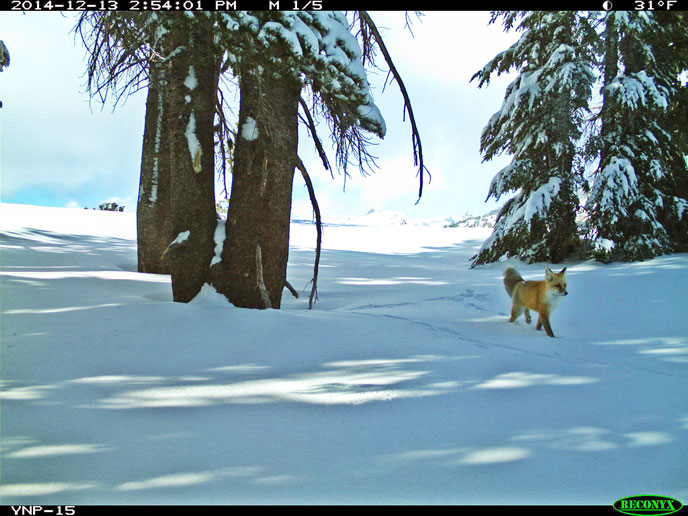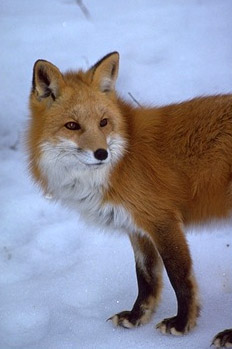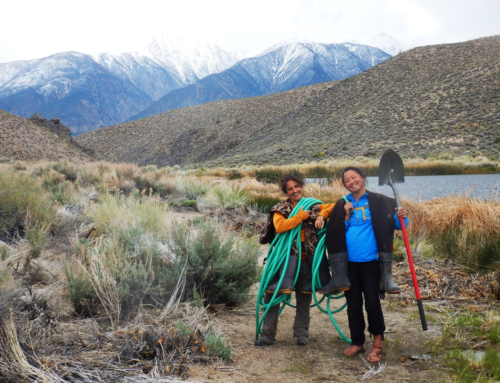
In 2014, the Sierra Nevada red fox made its first reappearance in Yosemite National Park for nearly 100 years.
In December 2014, a wildlife camera in Yosemite National Park captured this beautiful winter photo. And that fox trotting through the scene was more than just a fun find. It was proof of the first confirmed Sierra Nevada red fox in the park in nearly 100 years.
These foxes are special they’re different from the familiar low-elevation red foxes we see more often in nature and hear about in stories and folklore. The Sierra Nevada red fox is a particularly independent and attentive creature that is uniquely adapted to high-elevation alpine homes. Their unusually dense winter fur also covers their toe pads, acting as a kind of natural snowshoe. These solitary creatures also actively and firmly avoid human contact. All of these factors make this creature quite extraordinary, on top of the fact that they are exceptionally rare.

A photo from 2010 of the rare Sierra Nevada red fox, by the U.S. Department of Agriculture
They haven’t always been so rare. Sightings of them dwindled in the 1940s after trappers had sought out their soft, thick fur for many decades. California prohibited trapping in 1974, and the state then listed them as a threatened species in 1980.
As recently as 2010, biologists believed that no more Sierra Nevada red fox could be found in these mountains that is, until one turned up on a wildlife camera in the northern portion of the Eastern Sierra. Without motion-activated wildlife cameras, we may never have realized this elusive species is still here!
But today, experts estimate that only 20, maybe 50 foxes exist in their remote, high-elevation Eastern Sierra homes. This population is one of two dwindling groups of the Sierra Nevada red fox. There’s one other small group that lives in the southern Cascade Mountains of California, up north near Lassen National Forest.
These foxes are threatened by human disturbances and by warming caused by climate change that shrinks their habitat. And according to the San Francisco Chronicle, the U.S. Fish and Wildlife Service proposed this month to list this species as endangered.
But thanks to members, conservation partners, and supporters like you, Eastern Sierra Land Trust is helping protect species like the Sierra Nevada red fox.
Together, we’ve protected special places like Sceirine Point Ranch in Bridgeport Valley that provide important buffer zones that can benefit mountain-loving creatures.

© Keith Slausen, USFS/PSW
What is a “buffer” zone? While protected land in places like Bridgeport Valley directly provides homes for species that live there like Bi-State sage-grouse, mule deer, and badger, conservation on these private working ranches also benefits the public land that border them.
Protected valley lands provide a buffer that keeps mountain ecosystems healthy.
Wildlife don’t perceive property boundaries, and neither do plants, birds, nor insects – nature moves between and through the Eastern Sierra’s mosaic of ownerships. When more protected land surrounds the habitat of a rare species like the fox, it prevents development from encroaching on and affecting the edges of these creatures’ homes. And a wider breadth of open and protected land also boosts the population of different types of prey animals like rabbits and rodents. This, of course, helps mountain species like the fox to find food.
That’s why thanks to you, protected land in Bridgeport Valley and the surrounding area are helping an important part of our California heritage the handsome and hardy Sierra Nevada red fox survive and recover.
Learn more about how ESLT protects critical wildlife habitat.
Sources: Yosemite National Park – Sierra Nevada red fox blog post, Yosemite National Park – Sierra Nevada red fox description and biology.





